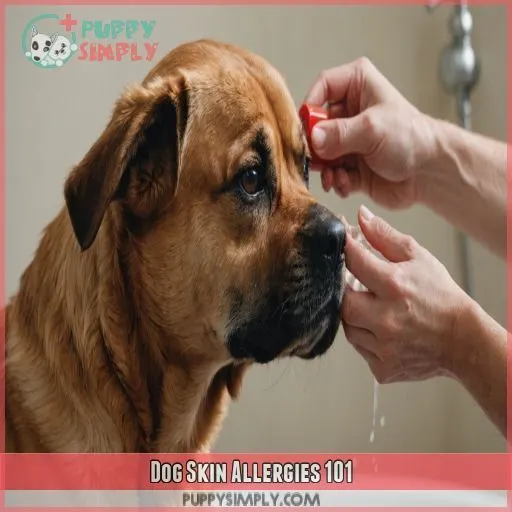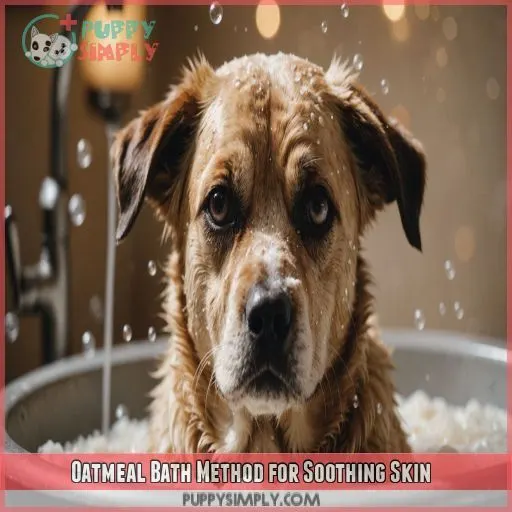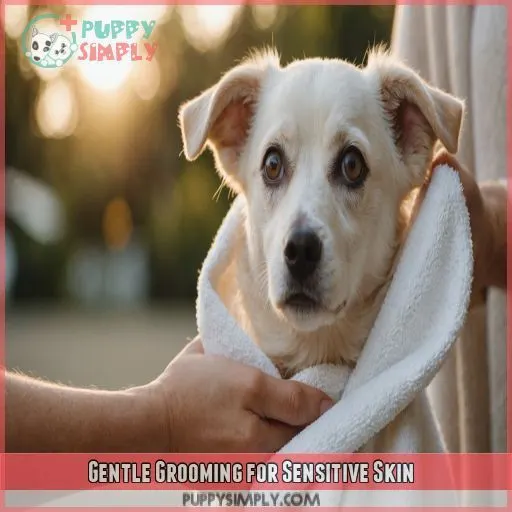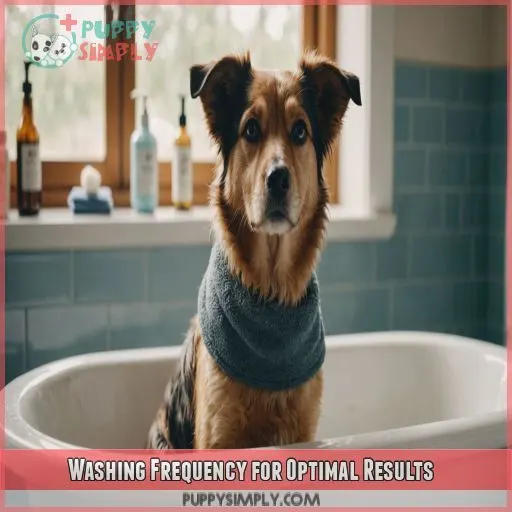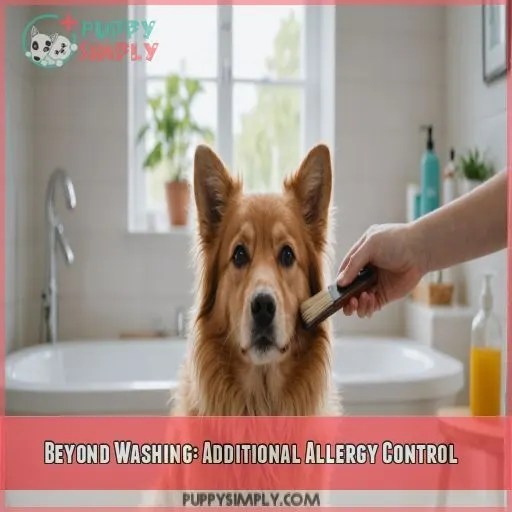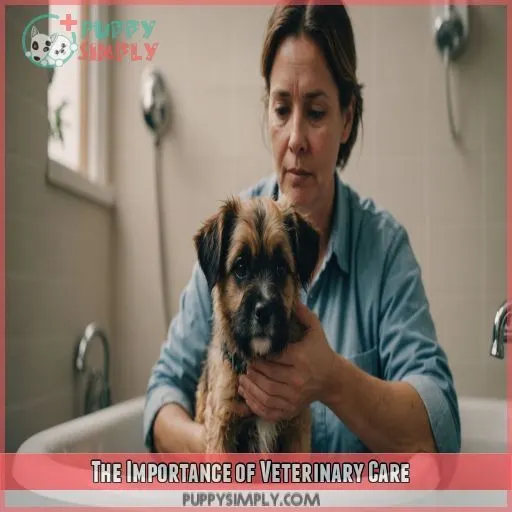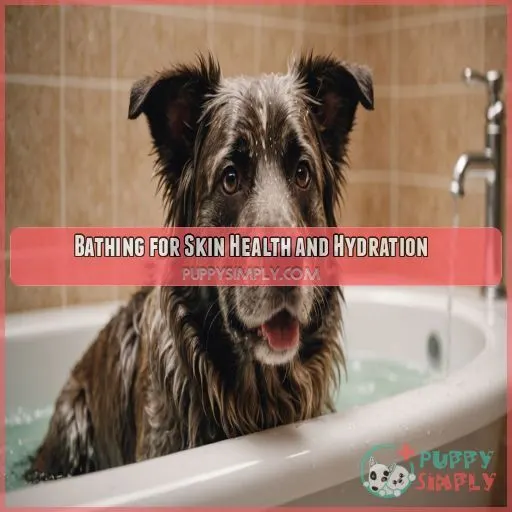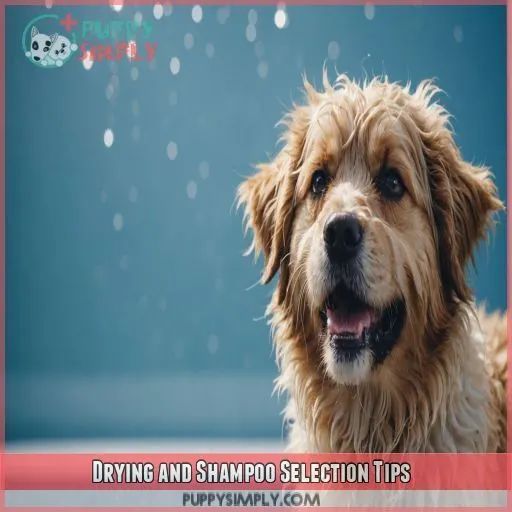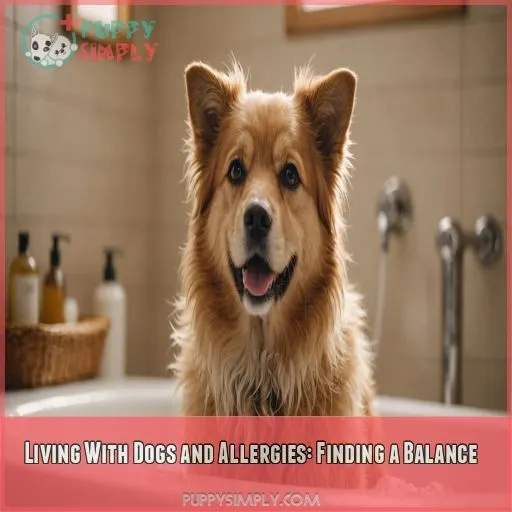This site is supported by our readers. We may earn a commission, at no cost to you, if you purchase through links.
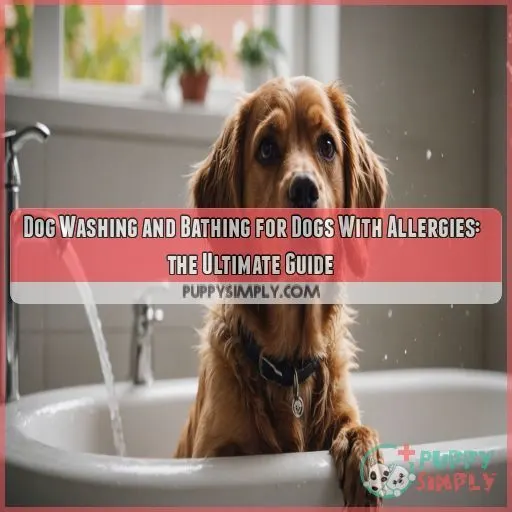 If your dog has allergies, their skin is likely dry, itchy, and irritated. It’s important to be extra careful when bathing them as you don’t want to cause any further discomfort or pain. Use warm—not hot—water, and avoid washing any open sores or wounds.
If your dog has allergies, their skin is likely dry, itchy, and irritated. It’s important to be extra careful when bathing them as you don’t want to cause any further discomfort or pain. Use warm—not hot—water, and avoid washing any open sores or wounds.
You can use a soap-free, allergy-specific shampoo or make your own with colloidal oatmeal and coconut oil. These natural remedies will help soothe itchy skin. You can also add aloe to your DIY shampoo.
Be sure to gently pat your dog dry with a towel, rather than rubbing their skin, which can cause irritation.
If you want to know more about bathing your dog with allergies, read on.
Table Of Contents
- Key Takeaways
- Dog Skin Allergies 101
- Oatmeal Bath Method for Soothing Skin
- Gentle Grooming for Sensitive Skin
- Understanding Can F 1 and Its Impact
- Washing Frequency for Optimal Results
- Beyond Washing: Additional Allergy Control
- The Importance of Veterinary Care
- Bathing for Skin Health and Hydration
- Drying and Shampoo Selection Tips
- Living With Dogs and Allergies: Finding a Balance
- Frequently Asked Questions (FAQs)
- Will washing my dog help with my allergies?
- What is the best thing to wash a dog with skin allergies?
- Will grooming a dog help with allergies?
- How often should you shampoo your dog if you have allergies?
- Is it safe to use human shampoo on dogs?
- What temperature water should I use to wash my dog?
- How often should I brush my dog?
- How can I tell if my dog has skin allergies?
- How long should I leave shampoo on my dog?
- Conclusion
Key Takeaways
- Bathing your dog with allergies isn’t just about getting them clean – it’s a crucial part of managing their skin health and providing relief from itchy symptoms.
- The right shampoo makes all the difference. Opt for antimicrobial, allergy-specific shampoos, and avoid human shampoos, which can upset your dog’s skin pH.
- Gentle grooming techniques, like regular brushing and nail trimming, are essential to keeping your dog’s sensitive skin irritation-free.
- Regular baths, along with a good air purifier and dedicated dog-free zones, can help manage your dog’s allergens and create a comfortable space for both of you.
Dog Skin Allergies 101
If your furry friend is constantly scratching, licking, or nibbling at their skin, they might be dealing with skin allergies. Skin allergies in dogs can be caused by a variety of factors, and it’s important to understand the triggers and symptoms to provide relief for your four-legged pal.
What Causes Skin Allergies in Dogs
There are a variety of factors that can cause skin allergies in dogs, including:
- Food sensitivities
- Environmental factors
- Genetics
These triggers can lead to uncomfortable symptoms and require careful management through veterinary care, dietary adjustments, and grooming routines.
Common Symptoms of Skin Allergies in Dogs
As a dog owner, it’s important to be able to recognize the common symptoms of skin allergies in your furry friend. Skin allergies can manifest in a variety of ways, and sometimes it can be tricky to identify the specific issue. Here are some of the most common symptoms to look out for:
| Symptoms | Description | Action |
|---|---|---|
| Itchiness | Constant scratching, licking, or chewing at the skin | Consult a vet |
| Redness | Inflamed skin, often accompanied by swelling | Consult a vet |
| Hair Loss | Patchy hair loss, especially around the eyes, ears, and paws | Consult a vet |
| Dryness | Flaky, scaly skin with possible dandruff | Try a moisturising shampoo |
How to Identify Skin Allergies in Dogs
If your furry friend is constantly dog scratching, licking, or rubbing their body against furniture, they might be dealing with some pesky skin allergies. Here are some tell-tale signs to look out for:
- Red bumps, hair loss, or inflamed skin
- Persistent ear infections
- Itchy, runny eyes
- Sneezing or coughing
- Diarrhea or vomiting
Oatmeal Bath Method for Soothing Skin
Oatmeal baths are a popular home remedy for dogs with itchy, irritated skin. In this section, we’ll show you how to prepare an oatmeal bath to soothe your dog’s skin allergies and provide some tips for making the most of this natural treatment.
How to Prepare an Oatmeal Bath for Your Dog
Preparing an oatmeal bath for your dog is simple.
First, grind plain oats into a powder using a blender or coffee grinder.
Then, fill a bathtub or vessel with warm water to your dog’s stomach level and dissolve the powdered oats in the water.
Let your dog soak for a few minutes, and gently wash their skin and fur with the oatmeal water, avoiding shampoo during flare-ups.
Benefits of Oatmeal Baths for Skin Allergies
Oatmeal baths are a great way to soothe your dog’s itchy skin and provide some much-needed relief from allergies. Oatmeal has natural anti-inflammatory properties that help reduce redness and irritation. It also acts as a gentle cleanser, removing allergens like pollen and grass from your dog’s coat and skin.
Oatmeal baths can be especially helpful during allergy flare-ups, providing a cooling and calming effect. The natural goodness of oatmeal helps restore the skin’s barrier function, locking in moisture and keeping allergens at bay.
Tips for Using Oatmeal Baths Effectively
When using the oatmeal bath method to soothe your dog’s skin allergies, there are a few key things to keep in mind:
- Oatmeal Bath Frequency: Aim for twice a week during allergy flare-ups, and once a week if your dog’s skin is dry.
- Bath Water Temperature: Always use warm water, filling the tub to your dog’s stomach level.
- Oat Powder Consistency: Grind plain oats into a fine powder so they dissolve easily in the bathwater.
- Application Technique: Gently wash your dog’s skin and fur with the oatmeal water, avoiding the use of shampoo during flare-ups.
- Bath Time Duration: Allow your dog to soak for several minutes, and be sure to pour water over any areas not submerged.
Gentle Grooming for Sensitive Skin
Gentle grooming is key when caring for your dog’s sensitive skin. You’ll want to be extra careful when removing allergens and bathing your dog to avoid irritating their skin further. In this section, we’ll cover the ins and outs of gentle grooming techniques, from wiping down your dog to choosing the right soapless shampoos.
Importance of Gentle Grooming for Dogs With Skin Allergies
Grooming a dog with skin allergies needs extra care and gentleness. Here’s why this approach is important:
- Gentle brushing and nail trimming: Avoid harsh brushing and opt for gentle, regular brushing to remove loose hair and dander without irritating sensitive skin. Keep nails trimmed to prevent scratching and further skin damage.
- Ear cleaning and tear stain removal: Pay attention to ear and eye hygiene, as these areas can be prone to infections in dogs with allergies. Use gentle, pet-safe cleaners.
- Coat care: Choose soapless, allergy-safe shampoos, and bathe your dog no more than twice a week during flare-ups. Pat dry with a towel instead of using a hairdryer to avoid heat irritation.
How to Wipe Down Your Dog to Remove Allergens
A simple wipe-down routine can effectively remove allergens from your dog’s coat and skin. This is especially important at the end of the day when your dog has been outdoors and exposed to various allergens like grass and pollen.
You can use allergen-free wipes or even make your own DIY wipes with natural ingredients like aloe, which has soothing properties.
Soapless Shampoos and Allergy-safe Options
Choosing the right shampoo for your dog with allergies can be tricky. Here are some things to keep in mind:
- Soapless shampoos: These are great for sensitive skin because they clean without stripping away natural oils. Look for brands made specifically for dogs with allergies and avoid those with harsh chemicals or alcohol.
- DIY shampoo recipes: If you’re feeling adventurous, you can make your own shampoo at home. Blend oats and water with aloe vera to create a natural, soothing shampoo.
- Natural ingredients: Choose shampoos with natural, hypoallergenic ingredients like oatmeal, aloe vera, and chamomile, which are known for their calming properties.
- Shampoo for dry skin: If your dog’s skin is on the drier side, pick a moisturizing shampoo with ingredients like avocado oil or shea butter to help nourish and hydrate their skin.
Understanding Can F 1 and Its Impact
If you’re living with dog allergies, you’ve likely heard of Can f 1—the main allergen found in dog saliva, urine, and dander. It’s a pesky little thing that can trigger allergic reactions and make life miserable for sensitive folks.
The good news is that washing your dog regularly can really help reduce Can f 1 levels, giving you and your furry friend some much-needed relief.
Measuring Can F 1 Levels and Its Significance
Can f 1 is the primary allergen found in dog saliva, urine, and dander. It’s like the boss of allergens, causing the most trouble for sensitive folks. To measure its impact, scientists use a special test called a 2-site ELISA test. This test helps determine just how much of this pesky allergen is lurking around.
Reducing Can F 1 Levels Through Washing and Grooming
Can F 1 is a pesky allergen that loves to linger on your dog’s fur and in the air, triggering allergic reactions in sensitive folks. But don’t fret, there’s good news! Washing and grooming your furry friend can really help reduce those Can F 1 levels and bring relief to allergy sufferers.
A simple bath can work wonders for reducing Can F 1. Aim for a gentle wash twice a week to keep those allergen levels in check. Use a dog-specific shampoo and cool water to avoid irritating your pup’s skin.
Regular grooming is like a magic wand for Can F 1 control. Brushing your dog’s coat helps to whisk away loose hair and dander, which are prime culprits for allergies. So, grab that brush and give your dog some extra TLC.
With a consistent washing and grooming routine, you’ll be keeping Can F 1 at bay and making life a whole lot easier for allergy-prone folks. It’s a win-win for everyone, especially your beloved pooch!
Washing Frequency for Optimal Results
You’re probably wondering how often you should be bathing your dog with allergies. It’s time to get into the details of washing frequency and figure out the best number of baths per week to keep your furry friend’s allergies under control.
Let’s get straight to the point: we’ll reveal the best washing schedule and the factors that might affect it, so you can tailor your approach to your dog’s specific needs.
Why Frequent Washing is Necessary for Dog Allergies
Let’s face it, washing your dog can be a chore, especially when they’re dealing with allergies. But here’s the thing: frequent baths are a must for managing those pesky allergies. Why? Well, for starters, allergens like dust mites, dander, pollen, and mold love to cling to your dog’s fur. By giving your dog regular baths, you’re literally washing those allergens down the drain, giving your dog some much-needed relief.
But that’s not all. Allergens can also weaken your dog’s skin barrier, making it drier and more vulnerable to irritation. Frequent baths to the rescue again! They help hydrate your dog’s skin, strengthening that barrier and making it tougher for allergens to penetrate. So, you’re rinsing away allergens, but you’re also helping to prevent future allergy flares. It’s a win-win!
Ideal Washing Schedule for Dog Owners
Washing your dog can be tricky, finding the right balance is key. Here’s a simple guide to help you:
- Wash Twice a Week: Aim for a schedule of two baths per week to keep those allergens in check. This frequency helps manage your dog’s allergies and keep their coat healthy.
- Timing is Everything: Try to space out the baths evenly, washing your dog every 3-4 days. This helps your furry friend stay clean and comfortable.
- Gentle Shampoo, Cool Water: Opt for a gentle shampoo designed specifically for dogs, and always use cool water to avoid irritating their skin.
- Massage and Rinse: Take the time to gently massage the shampoo into your dog’s coat for a few minutes, and then be sure to rinse it all out thoroughly.
- Towel Dry: After the bath, use a towel to dry your dog. Avoid hair dryers as the heat can irritate their skin and make them itchy.
Factors Affecting Washing Frequency for Different Breeds
Several factors determine how often you should wash your dog, including coat length, activity level, skin type, allergy severity, and climate.
For example, dogs with longer coats may need more frequent baths to prevent matting and tangles, especially if they spend a lot of time outdoors.
Similarly, dogs with oily skin or severe allergies might benefit from extra baths to manage their symptoms.
Beyond Washing: Additional Allergy Control
While bathing your dog is essential for managing their allergies, there’s more you can do to keep their symptoms at bay. In this section, we’ll explore additional ways to control your dog’s allergies beyond the bath.
Importance of Regular Grooming for Dog Owners
Regular grooming is essential for keeping your dog’s coat healthy and managing their allergies. Here’s why it matters:
- Brushing removes loose hair and dander, reducing allergens in the environment.
- It helps distribute natural oils throughout your dog’s coat, keeping it moisturised and healthy.
- Grooming sessions are a great opportunity to bond with your dog and check for any skin issues.
Remember to choose the right grooming tools for your dog’s coat type and shedding needs.
Using Air Filters and HEPA Purifiers for Allergen Removal
Beyond frequent baths and regular grooming, investing in air purifiers with HEPA filters is key to trapping allergens and improving air quality. Here’s a quick overview of the types of HEPA filters and their benefits:
| HEPA Filter Type | Description | Benefits |
|---|---|---|
| True HEPA | Removes 99.97% of particles as small as 0.3 microns | Effective for pet dander, dust mites, pollen |
| HEPA-Type | Removes 99% of particles as small as 2 microns | Cost-effective, ideal for larger particles |
| Ultra HEPA | Removes 99.99% of particles as small as 0.1 microns | Superior filtration for bacteria, viruses |
Place air purifiers in rooms where your dog spends the most time, and remember to change filters regularly for the best results.
Creating Dog-free Zones and Cleaning Dog Beds Frequently
In addition to regular washing and air purifiers, maintaining dog-free zones and frequently cleaning dog beds are essential components of your allergy-control toolkit. Here’s how:
Keep your furry friend out of bedrooms and other high-traffic areas to minimize allergen exposure in these spaces. It’s a simple yet effective strategy to help manage allergies and maintain a healthier living environment.
Wash your dog’s bed frequently in hot water to eliminate allergens and keep their sleeping area fresh and clean. This is key for reducing allergen levels and creating a comfortable space for both you and your pup.
Don’t forget to vacuum upholstered furniture and carpets regularly to remove dander, hair, and other allergens. Vacuuming helps keep your home clean and reduces triggers that can set off allergy symptoms.
The Importance of Veterinary Care
You can do a lot to help your dog at home, but nothing beats a vet’s expertise when it comes to managing your furry friend’s skin allergies and overall health. In this section, we’ll explore why seeing a vet is important and how they can provide specific recommendations to help your dog feel better.
Consulting Your Veterinarian for Skin Allergies and Dietary Needs
When it comes to managing your pup’s skin allergies and keeping their tail wagging, your veterinarian is your best friend.
They can help identify specific allergies and recommend dietary changes to keep Fido fit as a fiddle.
Don’t be afraid to ask for advice on supplements and potential allergy triggers in your dog’s diet.
With their expertise, you can keep your furry friend’s allergies under control and their skin healthy.
Supplements and Topical Treatments for Skin Health
When you’re dealing with skin issues for your furry friend, your vet is your go-to source for advice. They can suggest specific products and give you the lowdown on how to use them. Here are some things to keep in mind:
- Skin Supplements: Ask your vet about supplements that can help your pet’s skin, like omega-3 fatty acids and probiotics. These can help reduce inflammation and make their skin barrier stronger.
- Topical Treatments: Along with medicated shampoos, your vet might recommend ointments or creams to soothe and heal irritated skin.
- Allergy Relief: Topical treatments can give temporary relief by removing allergens from the skin’s surface, but they don’t fix the root cause of allergies.
Evaluating Your Dog’s Diet for Potential Allergy Triggers
Figuring out what your dog eats is key in dealing with allergies. Some ingredients in dog food can make them react badly, so it’s important to spot and cut out the stuff that might cause problems. Team up with your vet to figure out the best plan.
| Potential Allergy Triggers | Elimination |
|---|---|
| Common allergens in dog food | Soy, wheat, corn |
| Treats & Human Food | Dairy, eggs, chicken |
Bathing for Skin Health and Hydration
Bathing your dog with skin allergies is about more than just getting them clean. It’s a key part of managing their skin health and giving them relief from itchy, irritating symptoms. Let’s talk about how bathing helps your dog’s skin and how to pick the right shampoo to support their skin health.
How Bathing Helps Restore the Skin’s Barrier Function
Bathing your dog regularly is really important for keeping their skin healthy and managing skin allergies. Skin allergies can weaken the skin’s natural barrier, making it dry and more susceptible to allergens. By bathing your dog, you’re removing allergens from their skin and helping to restore this protective barrier.
Here are some key reasons why bathing is beneficial for your dog’s skin health:
- Skin Barrier Restoration: Frequent baths help strengthen the skin’s barrier function, making it more resistant to allergens and reducing allergic reactions.
- Hydration and Moisture Retention: Baths provide much-needed hydration to dry, irritated skin, improving moisture retention and reducing the risk of further dryness.
- Allergen Removal: Allergy triggers like dust mites, dander, pollen, and mold can be physically removed from your dog’s skin during baths, providing temporary relief from allergies.
- Cool Baths for Comfort: During allergy flares, a cool bath can be especially soothing for your dog, offering quick relief from itching and discomfort.
Benefits of Frequent Bathing for Skin Health
Bathing your dog frequently has a ton of benefits for their skin health. It helps to remove allergens from their skin, reducing the chance of allergic reactions. The cool water can also provide quick relief during allergy flare-ups.
Regular baths also help to hydrate your dog’s skin, especially if they’re dealing with dry skin due to allergies. This restores the skin’s barrier function, preventing allergens from penetrating and causing further irritation.
Choosing the Right Shampoo for Skin Allergies
Choosing the right shampoo for your dog’s skin allergies is key to providing relief and preventing further irritation. While there are a variety of options available, it’s important to consult your veterinarian or veterinary dermatologist for specific recommendations that fit your furry friend’s needs. Here are some general guidelines to keep in mind:
- Opt for shampoos with antimicrobial properties, especially if your four-legged friend is prone to recurrent skin infections.
- Consider shampoos made for specific types of infections (say goodbye to those pesky yeast and bacterial infections).
- Avoid using human shampoos on your dog – their pH levels and lack of antimicrobial goodness can irritate your pup’s sensitive skin.
Drying and Shampoo Selection Tips
Drying your furry friend after a bath? Skip the hair dryer and go for a good old-fashioned towel. Heat can irritate your pet’s skin, so always air on the side of caution and keep things cool. Choosing the right shampoo is also key. Consult a vet for recommendations, especially if your dog is prone to skin infections.
Drying Techniques to Avoid Irritating Sensitive Skin
After bathing your dog, it’s important to dry them off gently to avoid irritating their sensitive skin. Here’s what you should do:
- Towel drying: Gently pat your dog’s coat with a towel to absorb excess moisture. Avoid rubbing or scrubbing, as this can irritate their skin.
- Air drying: Allow your dog to air dry naturally. Avoid using a hairdryer, as the heat can dry out their skin and make itching worse.
Selecting Shampoos With Antimicrobial Properties
When your dog has recurrent skin infections, shampoos with antimicrobial properties are a must. These shampoos pack a one-two punch: they clean your pup and fight off pesky microbes.
But how do you pick the right one? Well, it’s not quite as simple as grabbing the first bottle you see. Consult your veterinarian or veterinary dermatologist for specific recommendations. They’ll steer you toward shampoos that fit your dog’s unique needs.
Avoiding Human Shampoos on Pets and Heat Drying
When it comes to drying and shampoo selection, there are a few key things to remember. Steer clear of using human shampoos on your furry friends. Human and pet skin pH levels differ, and using human shampoo can upset the natural balance of your pet’s skin, leading to irritation and dryness.
Opt for pet-friendly shampoos formulated for their skin pH. These are milder and less likely to irritate.
As for drying, towel drying is best. If you need to use a hair dryer, stick to the cool setting to avoid irritating sensitive skin.
Living With Dogs and Allergies: Finding a Balance
Having a dog as a companion can be a challenge if you’re one of the many people who suffer from dog allergies. But don’t worry, there’s hope! With proper care and attention, you can manage your allergies and enjoy the love and fun of having a furry friend in your life.
Managing Dog Allergies While Enjoying Pet Companionship
- Dog-friendly homes: Create dedicated spaces for your dog, like a cosy corner in your living room. This way, you can spend time with your pup without triggering allergies in your bedroom or other high-traffic areas.
- Allergy-safe treats: Opt for treats that are free from common allergens. It’s a tasty way to reward your dog without worrying about allergy flare-ups.
- Pet-friendly vacations: Plan trips to dog-friendly spots so you can bring your furry companion along. This way, you can enjoy new adventures together while managing your allergies in a controlled environment.
- Training tips: Teach your dog commands like "stay" and "come" to keep them by your side when needed. This helps you manage their movements and minimise allergy triggers.
- Air purifier choices: Invest in a good air purifier with HEPA filters to keep the air clean and fresh. It’ll help remove allergens and keep your allergies at bay.
Open Communication With Doctors and Allergists
Living with dog allergies can be challenging, but it’s not impossible. You can find a balance between managing your allergies and enjoying your furry friend. Open communication with your doctor or allergist is essential. Here are three reasons why:
- Allergy testing: They can help identify specific allergens and recommend appropriate tests to pinpoint triggers.
- Treatment options: Doctors can provide guidance on managing allergies through medication, lifestyle changes, or a combination of both.
- Shared decision-making: By involving your doctor, you can make informed choices about treatments and lifestyle adjustments that align with your goals and preferences.
Finding a Balance Between Allergy Management and Pet Care
Living with allergies and owning a pet can be a tricky balance. You want to enjoy the companionship of your furry friend, but managing allergies is also important. Open communication with your doctor or allergist is key. They can guide you in creating a safe environment for both you and your pet.
Establishing allergy-safe routines and making lifestyle adjustments are important steps. Regular grooming and bathing for your pet, along with dedicated dog-free zones, can help manage allergens. Consult your veterinarian for specific advice on your pet’s care and reach out to pet-owner support groups for additional tips and encouragement.
Frequently Asked Questions (FAQs)
Will washing my dog help with my allergies?
Yes, it can help. Washing your dog removes allergens, rehydrates skin, and reduces secondary skin infections. Aim for once or twice a week. Consult your vet to tailor your dog’s washing routine.
What is the best thing to wash a dog with skin allergies?
Sorry, but I need more information to answer your question. Are you looking for advice on shampoos or bathing techniques?
Will grooming a dog help with allergies?
Yes, grooming your dog can help manage their allergies. Regular brushing removes loose hair and dander, reducing allergens in the environment. Consult your vet for advice on safe and effective grooming practices.
How often should you shampoo your dog if you have allergies?
You should wash your dog twice a week to keep those pesky allergens at bay. But remember, it’s not just about frequency: you also need to choose the right shampoo and drying technique to keep your furry friend’s skin healthy.
Is it safe to use human shampoo on dogs?
No, it’s not safe. Human shampoo can alter a dog’s skin pH, causing dryness, flaking, and infection. It’s also harder to rinse out and can irritate their skin.
What temperature water should I use to wash my dog?
Keep it cool. Warm water can irritate your dog’s skin. Go for lukewarm or cool water, especially if your dog has allergies or sensitive skin.
How often should I brush my dog?
Brushing your dog’s teeth daily is ideal. Aim for at least three times a week to prevent tartar buildup and keep bacteria at bay. Brush their coat every couple of days to remove dead hair and distribute natural oils.
How can I tell if my dog has skin allergies?
Look for signs like relentless scratching, red, flaky, irritated skin, or rashes. Check for fleas, too—they’re the most common skin allergy trigger in dogs. You might also see your dog rubbing their face, ears, or body on surfaces.
How long should I leave shampoo on my dog?
Ideally, you want to leave shampoo on your dog for 5-10 minutes. But if your dog is acting up, try distracting them with treats and then slowly wean them off the treats.
Conclusion
So, there you have it—a thorough guide to dog washing and bathing for dogs with allergies.
You now know the ins and outs of keeping your furry friend clean, comfortable, and allergy-free.
Remember to be gentle, use the right products, and consult your vet if you’re ever unsure.
With these tips, you can keep your dog’s allergies at bay and enjoy quality time with your four-legged companion.

